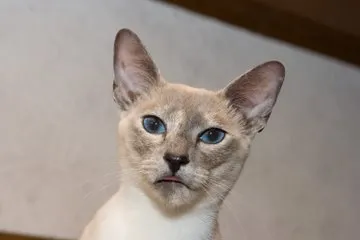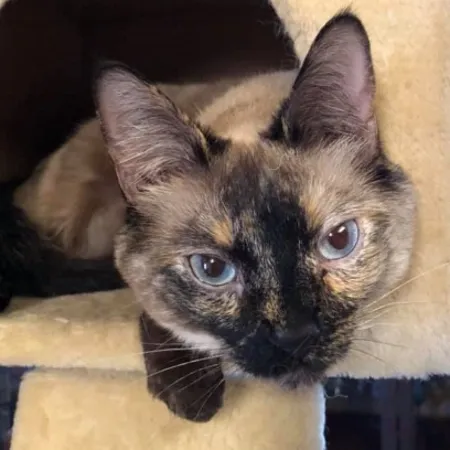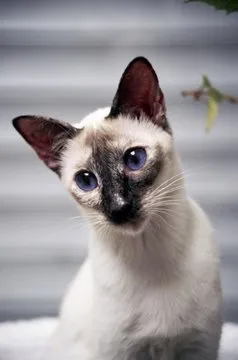Tortie Point Siamese cats captivate cat lovers with their unique, mottled patterns that blend classic Siamese points with tortoiseshell flecks. Unlike solid seal, chocolate, or blue points, a tortie point Siamese cat features a patchwork of colors on the face, ears, legs, paws, and tail—resembling a tortoise shell. These stunning combinations of dark points mixed with red, cream, or apricot shades make them stand out among Siamese varieties. If you’re drawn to snow tiger siamese patterns or other pointed breeds, the tortie point offers an even more intricate display.
This color pattern arises from specific genetics, resulting in beautiful, unpredictable mottling. For instance, a seal tortie point might show creamy body fur contrasting with a flecked mask of seal brown and red spots. Owners often describe their tortie point Siamese cats as visually striking and full of personality, blending the elegant Siamese build with vibrant, multi-toned extremities.
What Defines a Tortie Point Siamese Cat?
A tortie point Siamese cat gets its name from “tortoiseshell,” referring to the mottled or flecked points rather than uniform solid colors. Traditional Siamese points like seal, blue, lilac, or flame are single-hued, but torties introduce a mix, often including white spots for added variety. This occurs across base colors: seal with red, blue with cream, and more exotic shades like caramel with apricot.
 Siamese tortie point cat Yuki with flecked mask
Siamese tortie point cat Yuki with flecked mask
In memory of Yuki, image courtesy of Cindy Malnasi.
These patterns enhance the Siamese cat’s signature color-pointed body, where cooler body fur contrasts warmer extremities. Kittens may start with muddier tones that refine as they age, revealing the full tortie splendor. Veterinary experts note that while aesthetics draw enthusiasts, understanding the genetics ensures responsible breeding and health awareness in tortie point Siamese cats.
The Genetics Behind Tortie Point Siamese Cats
Tortie points stem from the interaction of the Siamese’s temperature-sensitive color gene and the orange (O) gene, which converts black pigment to red shades. Purebred Siamese in solid colors like seal or chocolate lack the O gene, but crossing with an orange-carrying cat introduces it. Males (XY chromosomes) express full red points with one O gene, while females (XX) need two for solid red—making torties predominantly female.
This X-linked trait causes random inactivation of one X chromosome in females, known as X-inactivation or Lyonization. Half the pigment cells produce dark points (e.g., seal), the other half red variants, creating the mottled effect. A seal tortie point Siamese cat thus shows seal brown interspersed with red on points, while blue torties mix blue and cream. This mirrors why non-pointed tortoiseshell cats are nearly always female—a rare male requires XXY genetics.
 Blue Tortie Point Siamese Cat
Blue Tortie Point Siamese Cat
Blue tortie point Siamese cat, image © Martin Bahmann | Creative Commons.
Breeders emphasize ethical practices, as forcing tortie traits can risk health issues common in Siamese lines, like dental problems or heart conditions. Consulting bodies like the Governing Council of the Cat Fancy (GCCF) provides standards for recognizing healthy tortie point Siamese cats.
Variations of Tortie Point Siamese Cats
The GCCF recognizes seven tortie point varieties, each with distinct point and body colors:
- Seal Tortie: Seal brown points with red shades; cream body (muddy fawn in kittens).
- Blue Tortie: Light blue points with cool cream; glacial white body. Similar to patterns in seal point himalayan cat breeds.
- Chocolate Tortie: Milk chocolate points with red; ivory body.
- Lilac Tortie: Pinkish grey points with cool cream; off-white (magnolia) body.
- Cinnamon Tortie: Warm cinnamon brown points with red; ivory body.
- Caramel Tortie: Brownish grey points with apricot; off-white body.
- Fawn Tortie: Warm pale rosy mushroom points with cream; off-white body.
These variations allow for diverse aesthetics, much like colorpoint ragdoll cats with their pointed motifs. Owners report tortie point Siamese cats mature into vivid displays by 2-3 years, influenced by environment and diet.
 Siamese tortie point cat Chloe
Siamese tortie point cat Chloe
Ms. Chloe, image courtesy of Cara Holland.
 Seal Tortie Point Siamese cat
Seal Tortie Point Siamese cat
Seal tortie point Siamese cat, image © Kamée | Creative Commons.
Proper care mirrors standard Siamese needs: high-protein diet, dental hygiene, and regular vet check-ups to monitor for breed-specific issues. Experiences from owners highlight their affectionate nature, often forming strong bonds akin to other pointed Siamese.
Caring for Your Tortie Point Siamese Cat
Beyond genetics, tortie point Siamese cats thrive with tailored care. Provide kitten milk replacer if orphaned, transitioning to quality wet food supporting urinary health—a Siamese vulnerability. Interactive play prevents obesity, and annual exams catch early signs of amyloidosis or glaucoma.
Real-world insights from breeders confirm mottling stabilizes post-neutering, with no impact on temperament. For those comparing to longhair variants, tortie points shine in sleek Siamese coats.
Final Thoughts on Tortie Point Siamese Cats
Tortie point Siamese cats blend genetic marvels with visual allure, from seal tortie flecks to fawn-cream mixes. Mastering their O-gene origins equips enthusiasts for informed adoption or breeding. Always prioritize health from reputable sources like GCCF-registered catteries.
Consult a veterinarian for personalized advice, and explore more on Siamese colors to enrich your feline journey. Share your tortie point stories below!
References:
- Governing Council of the Cat Fancy (GCCF): Siamese Color Standards.
- Cat Fanciers’ Association (CFA): Genetics of Tortoiseshell Patterns.
